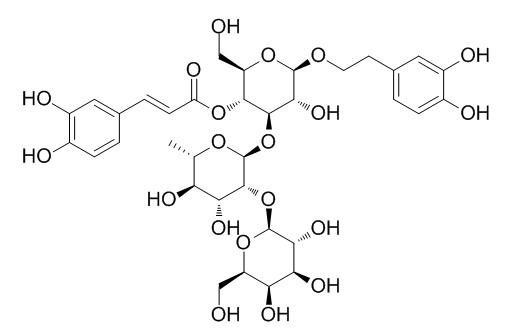Teupolioside
Teupolioside and verbascoside show anti-inflammatory and wound healing activities, they are extremely effective inhibitors of chemokine and growth factor expression by cultured human keratinocytes treated with pro-inflammatory cytokines, TNF-alpha and interferon-gamma.
Inquire / Order:
manager@chemfaces.com
Technical Inquiries:
service@chemfaces.com
Tel:
+86-27-84237783
Fax:
+86-27-84254680
Address:
1 Building, No. 83, CheCheng Rd., Wuhan Economic and Technological Development Zone, Wuhan, Hubei 430056, PRC
Providing storage is as stated on the product vial and the vial is kept tightly sealed, the product can be stored for up to
24 months(2-8C).
Wherever possible, you should prepare and use solutions on the same day. However, if you need to make up stock solutions in advance, we recommend that you store the solution as aliquots in tightly sealed vials at -20C. Generally, these will be useable for up to two weeks. Before use, and prior to opening the vial we recommend that you allow your product to equilibrate to room temperature for at least 1 hour.
Need more advice on solubility, usage and handling? Please email to: service@chemfaces.com
The packaging of the product may have turned upside down during transportation, resulting in the natural compounds adhering to the neck or cap of the vial. take the vial out of its packaging and gently shake to let the compounds fall to the bottom of the vial. for liquid products, centrifuge at 200-500 RPM to gather the liquid at the bottom of the vial. try to avoid loss or contamination during handling.
Food Chemistry: X2023, 101032.
Evid Based Complement Alternat Med.2017, 2017:9764843
The Journal of Supercritical Fluids2021, 176:105305.
Agriculture.2024, 69(3):140-148.
Biomedicines.2024, 12(3):495.
J Ethnopharmacol.2019, 241:112025
Int J Mol Sci.2020, 21(24):9369.
Academic J of Second Military Medical University2018, 39(11)
Translational Neuroscience2024, 15:20220339
Buildings2023, 13(5), 1112.
Related and Featured Products
Cellular & Molecular Biology, 2007, 53(5):84-91.
Molecular mechanisms underlying wound healing and anti-inflammatory properties of naturally occurring biotechnologically produced phenylpropanoid glycosides.[Reference:
WebLink]
Two phenylpropanoid glycosides, verbascoside (VB) and Teupolioside (TP), produced biotechnologically by Syringa vulgaris and Ajuga reptans plant cell cultures, were studied in vitro and in vivo for their anti-inflammatory and wound healing activities.
METHODS AND RESULTS:
It was shown that TP- and VB-containing extracts significantly accelerated wound healing and possessed remarkable anti-inflammatory action in the excision wound model. These effects correlated with the inhibition of reactive oxygen species release from the whole blood leukocytes and with the ferrous ion chelating capacity. On the other hand, they don't correlate either with free radical scavenging or with the inhibition of lipid peroxidation in the cell-free systems. Furthermore, both VB- and TP-containing extracts were extremely effective inhibitors of chemokine and growth factor expression by cultured human keratinocytes treated with pro-inflammatory cytokines, TNF-alpha and interferon-gamma.
Biochemical pharmacology, 2009, 77(5):845-857.
Teupolioside, a phenylpropanoid glycosides of Ajuga reptans, biotechnologically produced by IRBN22 plant cell line, exerts beneficial effects on a rodent model of colitis.[Reference:
WebLink]
The aim of the present study was to examine the effects of phenylpropanoid glycoside, Teupolioside, biotechnologically produced by IRBN22 Ajuga reptans cell line, in rats subjected to experimental colitis.
METHODS AND RESULTS:
Colitis was induced in rats by intracolonic instillation of dinitrobenzene sulfonic acid (DNBS). Teupolioside was administered daily orally (0.2 or 2mgkg(-1)). On Day 4, animals were sacrificed and tissues were taken for histological and biochemical analysis. Four days after DNBS administration, colon TNF-alpha and IL-1beta productions were increased, associated with colon damage. Neutrophil infiltration, by myeloperoxidase activity, in the mucosa was associated with up-regulation of ICAM-1 and P-selectin and high levels of malondialdehyde. Immunohistochemistry for nitrotyrosine and poly (ADP-ribose) polymerase (PARP) showed an intense staining in the inflamed colon. Biochemical methods and zymography were used to analyze MMP-9 and -2 activities in colon tissues from DNBS-injured rats. Treatment with Teupolioside significantly reduced the appearance of diarrhoea and the loss of body weight. This was associated with a remarkable amelioration in the disruption of the colonic architecture and a significant reduction in colonic myeloperoxidase activity and malondialdehyde levels. Teupolioside also reduced the pro-inflammatory cytokines release, the appearance of nitrotyrosine and PARP immunoreactivity in the colon and reduced the up-regulation of ICAM-1 and the expression of P-selectin. Therefore, Teupolioside also reduced proMMP-9 and -2 activity induced in the colon by DNBS administration.
CONCLUSIONS:
The results of this study suggested that administration of Teupolioside may be beneficial for treatment of inflammatory bowel disease.
Journal of Molecular Catalysis B Enzymatic, 2014, 104:42-47.
Enzymatic acylation as an efficient tool for an easy access to specific acyl derivatives of the natural antioxidants verbascoside, teupolioside and echinacoside.[Reference:
WebLink]
METHODS AND RESULTS:
The natural antioxidants phenylpropanoids glycosides echinacoside (1), verbascoside (2) and Teupolioside (3) were efficiently and regiospecifically monoacylated by means of the enzyme lipase PS. While acylation of Teupolioside (3) and of echinacoside (1) occurred at a sugar primary OH in the “lower” or in the “upper” part of the molecule, respectively, verbascoside (2) was acetylated at one of its sugars secondary OHs.
CONCLUSIONS:
At variance to enantioselectivity, which can be rationalized in terms of steric effects due to substituents bulkiness, our new results confirm that enzyme regioselectivity is mainly dictated by the electrostatic interactions of the different OHs of the substrates with the amino acids of the enzyme.



